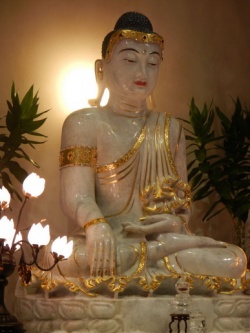Bodhiruci
Bodhiruci (菩提留支, 5th–6th centuries) means Bodhi splendor. A Buddhist master from northern India, he was versed in Mantra practices and the Tripiṭaka. Aspiring to propagate the Dharma, in 502, the first year of the Yongping (永平) years of the Northern Wei Dynasty (386–534), he arrived in Luoyang (洛陽), China’s capital. Emperor Xuanwu (魏宣武帝) valued him highly and commanded him to stay in the Yongning Temple (永寧寺) to translate Sanskrit texts into Chinese. He translated thirty-nine texts in 127 fascicles, including the Diamond Sūtra (T08n0236), The Buddha Name Sūtra (T14n0440), the 10-fascicle version of the Laṅkāvatāra Sūtra (T16n0671), the Sūtra of the Profound Secret Liberation (T16n0675), the Sūtra of Neither Increase Nor Decrease (T16n0668), and the Dharma Collection Sūtra (T17n0761), as well as treatises, such as the Treatise on the Ten grounds Sūtra (T26n1522), the Treatise on the Great Treasure Pile Sūtra (T26n1523), and the Upadeśa on the Sūtra of Amitāyus Buddha (T26n1524). After 537, Bodhiruci was not seen again.
Bodhiruci expressed his unique view on The Buddha’s teachings. Based on the MahāParinirvāṇa Sūtra (T12n0374), he said that, for the first twelve years, The Buddha gave only half-worded teachings, followed afterward by fully-worded teachings. Bodhiruci also proposed the one tone theory, saying that The Buddha pronounces teachings in one tone, and Sentient beings come to a variety of understandings according to their capacities. Furthermore, based on the Laṅkāvatāra Sūtra, he proposed the distinction between immediate and gradual Enlightenment.
Bodhiruci was a Buddhist monk and esoteric master from North India (6th century CE). He became very active as a teacher following his arrival in Loyang, China in 508 (during the Northern Wei).
He produced translations of 39 works in 127 fascicles, including the Sutra on the Ten grounds (Chi. 十地経論) and commentary, and the Shorter Sukhāvati Sutra with commentary. The former text became the chief object of study for the Ti-lun (地論) School, of which Bodhiruci is regarded as the Patriarch.
